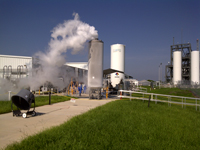 Misconceptions abound in the world, and some are more important to address than others. In the area of cryogenic heat management there are misconceptions that usually have no ill effect but sometimes can become big stumbling blocks. These center around the confusion of temperature and heat (with the word “thermal” thrown in here and there). Temperature is an indicator of what the heat is doing, but it is not heat.
Misconceptions abound in the world, and some are more important to address than others. In the area of cryogenic heat management there are misconceptions that usually have no ill effect but sometimes can become big stumbling blocks. These center around the confusion of temperature and heat (with the word “thermal” thrown in here and there). Temperature is an indicator of what the heat is doing, but it is not heat.
In cryogenics, like all other fields in the known universe, heat flows from the hotter region to the colder region. This simple fact, based entirely on observation, is at the center of the laws of thermodynamics. The notion of temperature, an indicator of the amount of heat in an object, provides the basis for those laws. But what is this energy called heat? No one knows, but whatever it is, it flows from the hotter side to the colder side. If there are two different temperatures, and some physical proximity or connection between the two, the heat is flowing. Directing or re-directing, organizing, or orchestrating – and promoting or inhibiting this flow of heat is the job of the cryogenic engineer.
So here are five misconceptions in the world of cryogenics, as well as any world that deals with heat or “heat energy.”
1. Thermal energy and heat are the same thing. No, they are not. Thermal energy is thermal energy, and heat is heat. Heat is not heat energy. Heat is heat. What is the difference? Thermal energy has to do with the intrinsic nature of solid matter at the microscopic and smaller levels. Heat has to do with systems and is coupled with the production of work. If you don’t agree with this first one, let me hear about it. There is no universal consensus on it, but we must start somewhere.
2. Insulation does not “keep the liquid hydrogen cold.” Or any cryogenic liquid, ever. Coming up through the Space Shuttle program and working in connection to the cryogenic propulsion systems, LO2 and LH2, for 38 years, I would hear that all the time on the news. Does it matter? Not usually. But sometimes it can. That liquid in that vessel will stay at the same temperature if it has a ten-meter-thick insulation or if it is completely uninsulated. It is the rate of vaporization of the liquid, or loss of the product, that really matters.
3. Heat transfer occurs through the insulation of the cryogenic tank at steady-state conditions. There is a bit of semantics here, but the point is that heat is continually being transmitted through the thickness of the material from the warmer surface to the colder surface. There is not some quantity of heat in one location that is transferred to another location. Most cryogenic systems (and their insulation systems), like storage tanks or refrigeration process towers, are cooled and put into operation for continuous steady-state operation for days, weeks, months, or even years at a time. Heat transmission is the correct term. In the beginning, at those first moments of cooldown or cold shock, there was a lot of heat transfer going on as the materials were adjusting from their starting ambient temperature conditions. Thereafter, the heat is being continually transmitted in steady-state fashion from the outer surface (ambient) to the inner surface (cold mass).
4. Heat does not flow as a function of temperature. Heat flows according to the temperature difference imposed on the system. This one is a two-part misconception, as data are often given as follows: thermal conductivity as a function of temperature. This is an especially tricky one as now there is the moment that the distinction between heat and temperature really matter. First, there is the error of using the word “thermal” when it really is “heat.” Then there is the word “conductivity” which has to do with the transmission of heat through a solid material that is isotropic and homogeneous (a limited case). Finally, heat does not flow if everything is at the same temperature.
5. There is no such thing as hot and cold. There is only hotter than and colder than.
I’m sorry to bring this sad news on number 5, but there is a bright spot and that is the Third Law of Thermodynamics. The Third Law gives us our foundation, absolute zero (0 K). We can’t go down from there; we can only go up. If we go up to 0.1 K, then there is some heat. If we go up further to 1 K, there is more heat. And up to 10 K, more heat. And so on, up and up, as high as we can imagine. At absolute zero, there is no heat. Above that, it’s all heat.
Cryogenics is about the “cold.” But when we look carefully, we see that cold and hot are not opposites, but rather two sides of one coin called heat.
By James E. Fesmire, President, Energy Evolution LLC, [email protected]


